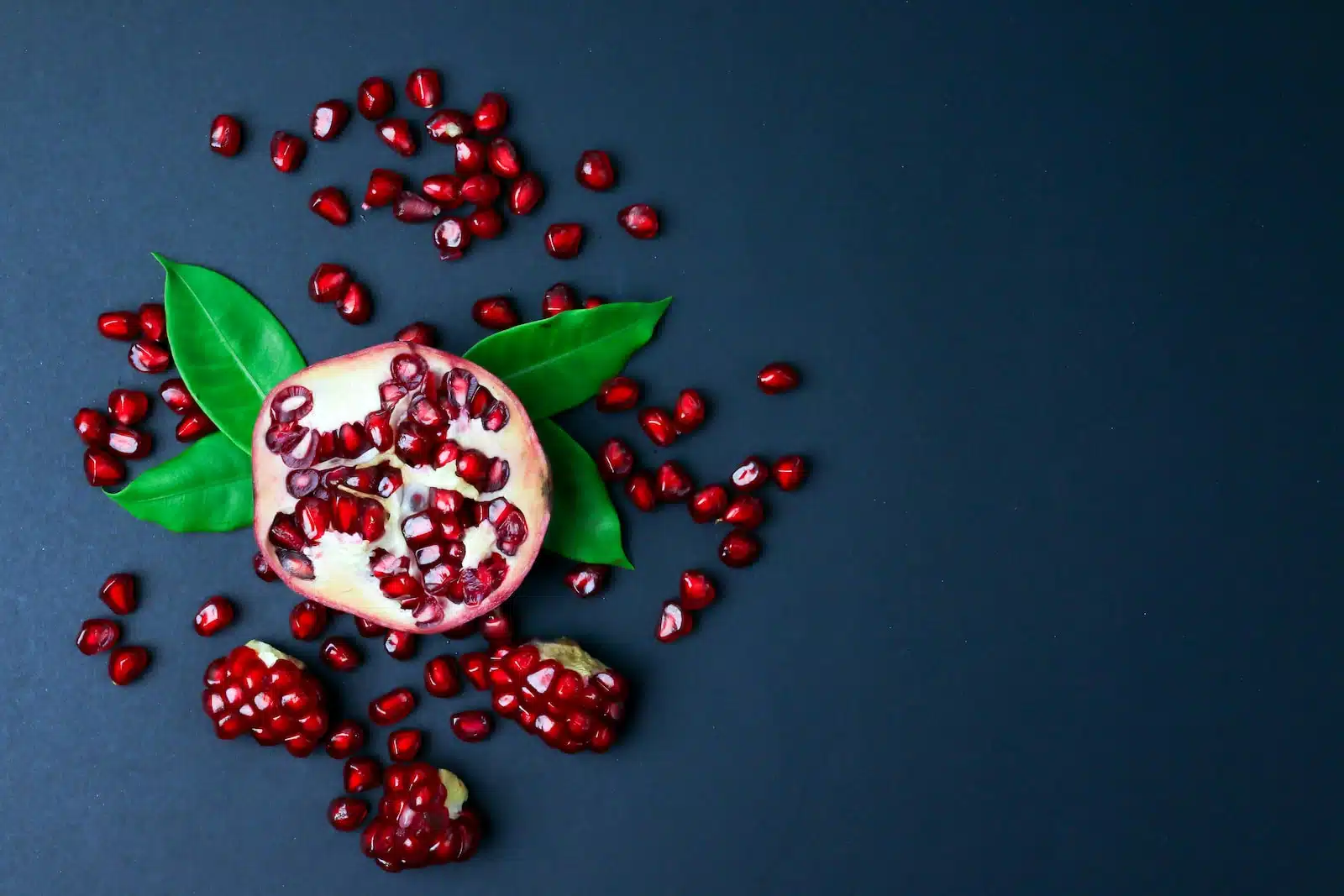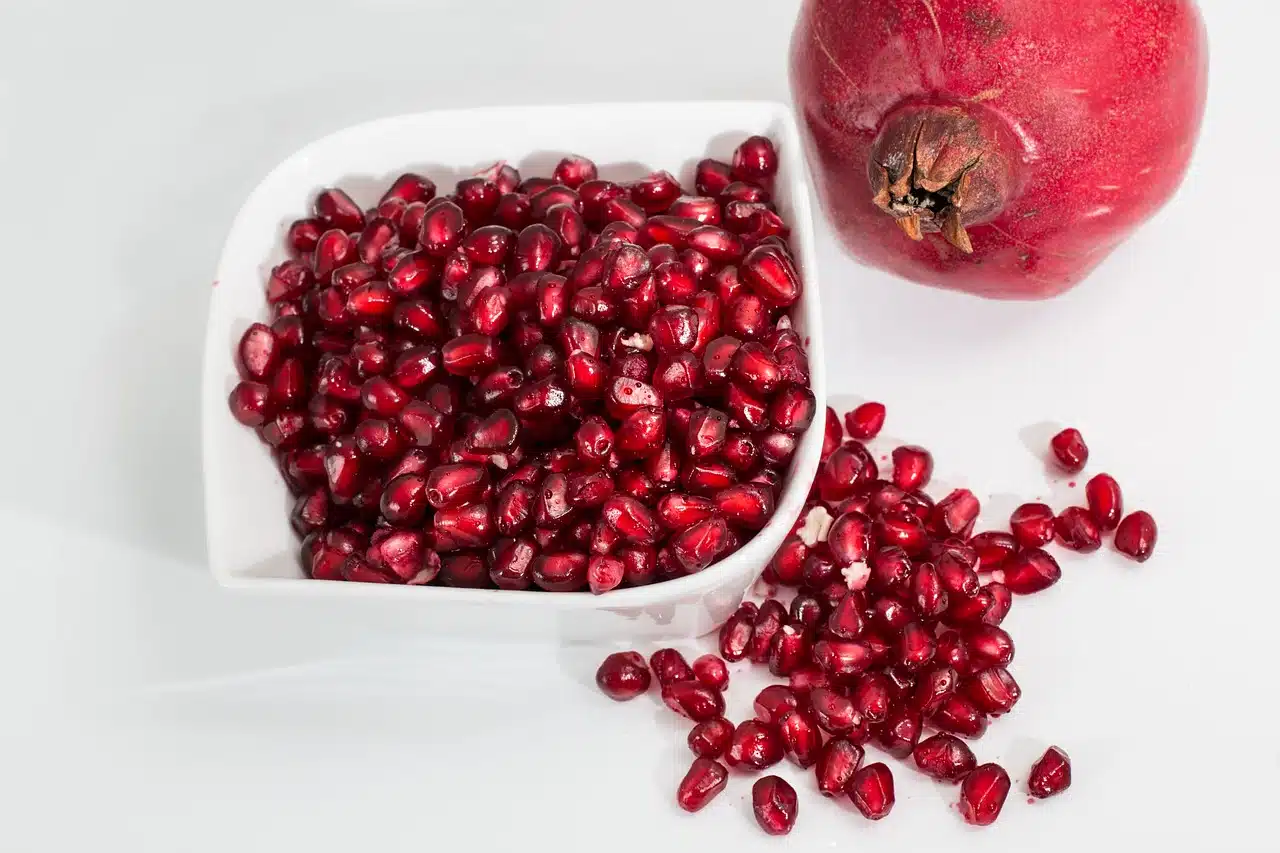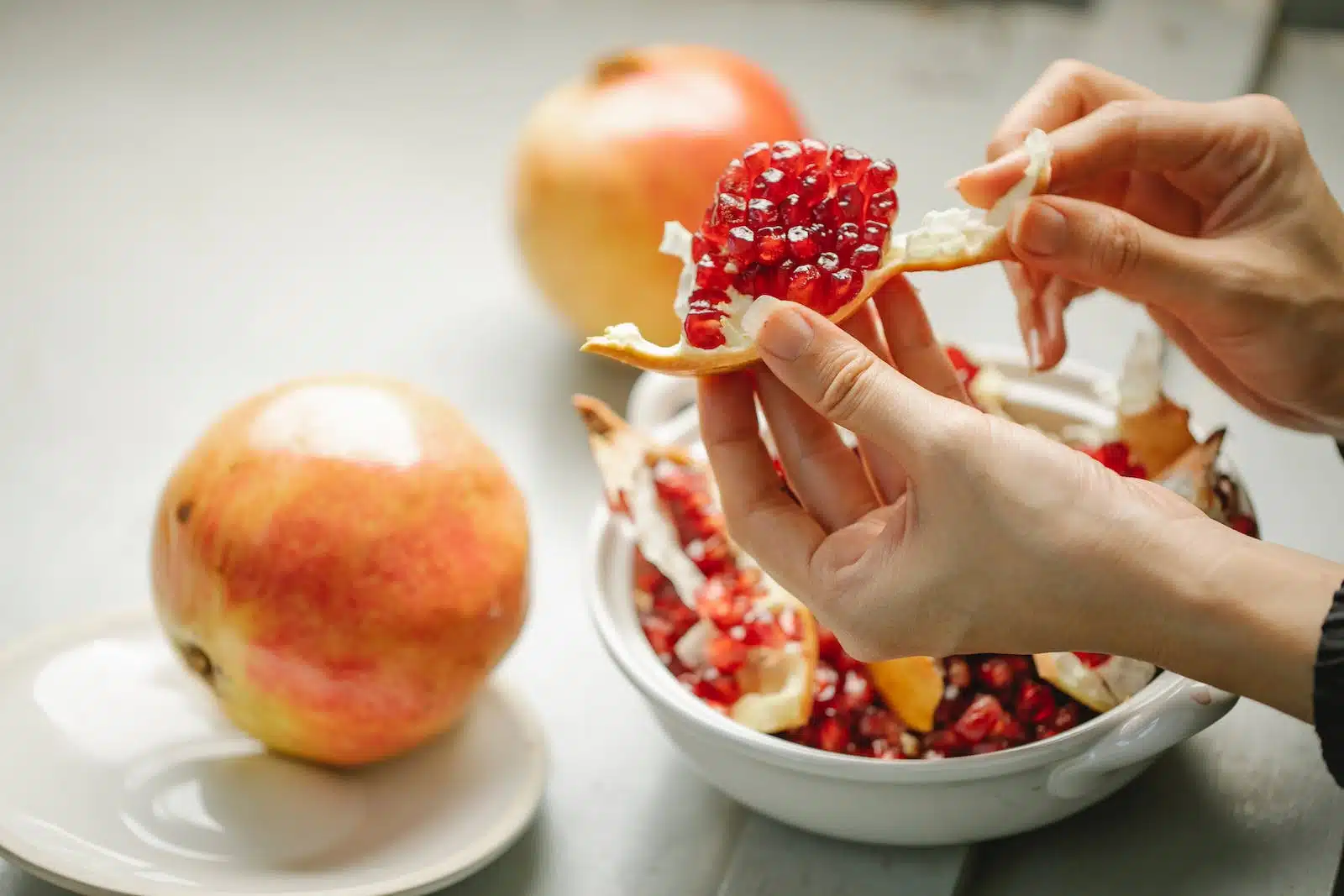Are you struggling with keeping your pomegranate seeds fresh and tasty? I know the frustration of wanting to savor those juicy, flavorful seeds, only to find them going bad too quickly. Did you know that properly storing pomegranate seeds can extend their shelf life by weeks? After conducting extensive research, I’ve gathered some valuable tips and techniques that will help you preserve the freshness of your pomegranate seeds for longer periods.
If you’re tired of throwing away unused or spoiled pomegranate seeds, then this article is for you. I’ll be sharing practical methods and best practices for storing these delicious seeds so that you can enjoy them whenever cravings strike! So let’s dive in and discover how to keep those vibrant red jewels perfectly fresh.
Key Takeaways
- Store pomegranate seeds in the fridge using airtight containers to keep them fresh for up to five days.
- Dehydrate seeds at 140°F for 24 – 36 hours and store in a cool, dark place to extend shelf life even more.
- Use lemon juice or sugar syrup as preservatives to maintain seed quality and add flavor when storing.
- Vacuum-sealing removes air, protecting seeds from freezer burn and spoilage for long-term storage.
- Choosing ripe pomegranates and handling the seeds gently are crucial steps before storing them properly.
Storing pomegranate seeds properly is vital to keeping them fresh and tasty. Without the right storage methods, these juicy gems can quickly go bad, leading to unnecessary waste. I make sure to preserve the quality of pomegranate seeds by using techniques like refrigeration or freezing for short-term needs.
For long-term storage, dehydrating or vacuum-sealing are fantastic options that maintain their goodness for months. It’s about choosing the method that best suits how soon I’ll use them again.
Whether in salads or as a sweet snack, my well-stored pomegranate arils always add a burst of flavor and color to any dish.
Why Properly Storing Pomegranate Seeds is Important?

Properly storing pomegranate seeds is important for maintaining their freshness and quality, as well as avoiding waste. This ensures that you can enjoy the delicious taste and health benefits of pomegranate seeds for a longer period of time.
Maintaining Freshness and Quality
Keeping pomegranate seeds fresh means handling them with care right from the start. I make sure to store my pomegranate arils in the refrigerator, as this slows down decay and preserves their juicy crunch.
It’s crucial to use airtight containers or resealable bags to protect them from absorbing other odors and moisture which can impact quality.
I’ve found that vacuum-sealing is a fantastic method for prolonging shelf life if you’re planning long-term storage of pomegranate seeds. This technique removes air and seals in freshness, ensuring that when I’m ready to enjoy my stored seeds, they’re just as tasty as on day one.
By consistently maintaining optimal conditions inside my kitchen fridge, I prevent early spoilage of those ruby-red jewels.
Avoiding Waste
To avoid waste, it’s important to store pomegranate seeds properly so they stay fresh for a longer period. Proper storage methods such as refrigeration, dehydrating, or preserving in sugar syrup can help maintain the quality of the seeds and prevent them from spoiling too quickly.
By choosing ripe pomegranates and using suitable storage containers under ideal conditions, you can extend the shelf life of the seeds and minimize any unnecessary discard.
Taking steps to preserve and maintain the freshness of pomegranate seeds not only reduces waste but also ensures that you always have delicious and nutritious arils on hand for a variety of culinary uses.
Methods for Storing Pomegranate Seeds

When it comes to storing pomegranate seeds, there are several methods you can use to keep them fresh and flavorful, such as refrigeration, dehydrating, preserving in sugar syrup, using lemon juice, and vacuum-sealing.
Each method has its benefits and can help extend the shelf life of your pomegranate seeds.
Refrigeration
Refrigeration is an effective way to store pomegranate seeds. I place the seeds in an airtight container and keep them in the refrigerator at a consistent temperature of 32 to 41 degrees Fahrenheit.
This helps maintain their freshness and extends their shelf life, ensuring that they stay juicy and flavorful for up to five days.
Now let’s move on to exploring “Dehydration” as another method for storing pomegranate seeds.
Dehydrating
Dehydrating pomegranate seeds is a simple method to extend their shelf life. Start by spreading the arils in a single layer on a dehydrator tray lined with parchment paper. Set the dehydrator to 140°F and dry the seeds for 24-36 hours until they are firm but not overly dry.
Once dried, store them in an airtight container in a cool, dark place. Dehydrated pomegranate seeds can be used as toppings for salads, yogurt, or oatmeal and can also add a delightful crunch to baked goods or trail mixes.
When dehydrating pomegranate seeds: spread them evenly on trays; set the dehydrator at 140°F; ensure they are only firm after drying; then store them in an air-tight container in a cool area.
Preserving in Sugar Syrup
After dehydrating pomegranate seeds, another effective way to preserve them is by storing them in sugar syrup. This method not only helps maintain the freshness and flavor of the seeds but also adds a touch of sweetness, making them a delightful addition to various dishes and desserts.
To start, prepare a simple sugar syrup by combining water and sugar in a pot over low heat until the sugar completely dissolves. Once the syrup cools down, pour it over the pomegranate seeds in an airtight container, ensuring they are fully submerged.
Seal the container tightly and store it in the refrigerator for an extended shelf life. The sweetened pomegranate seeds can be used as toppings for yogurt, or ice cream, or mixed into cocktails for a burst of flavor.
Using Lemon Juice
Lemon juice is an effective way to keep pomegranate seeds fresh for longer periods. The citric acid in lemon juice helps prevent browning and maintains the vibrant color of the arils.
Simply toss the seeds in a bowl with some lemon juice before storing them in an airtight container in the refrigerator. This method not only preserves the visual appeal of the seeds but also enhances their flavor, adding a subtle citrusy note to them.
Moving on to “Vacuum-sealing,” this technique provides an air-tight seal that effectively prolongs the shelf life of pomegranate seeds, maintaining their freshness and quality for an extended period.
Vacuum-Sealing
Transitioning from using lemon juice as a preservation method, vacuum-sealing is an effective way to store pomegranate seeds for extended periods. The process involves placing the seeds in a vacuum-seal bag and removing all air from it to prevent oxidation and spoilage.
This method helps maintain the freshness, flavor, and nutritional value of the pomegranate seeds for longer durations, making them readily available for future use without compromising their quality.
Vacuum-sealing also prevents freezer burn when storing pomegranate seeds in the freezer, ensuring that they retain their taste and texture when thawed. Additionally, this technique eliminates excess moisture within the packaging, further prolonging the shelf life of the seeds.
Best Practices for Storing Pomegranate Seeds

When it comes to storing pomegranate seeds, it’s important to start with selecting ripe fruits and properly washing and preparing the seeds. Choosing the right storage containers and ensuring ideal storage conditions are also crucial for maintaining their freshness.
Selecting Ripe Pomegranates
When selecting ripe pomegranates, look for fruits that are heavy for their size and have a deep color. The skin should be firm and free from blemishes, indicating ripeness and freshness.
Additionally, check for a metallic sound when tapping the fruit, a sign of plump arils inside. Remember to choose pomegranates with smooth, unbroken skin as this ensures the seeds inside are undamaged and perfect for storage.
To pick ripe pomegranates, remember to feel them; they should be heavy in your hand which indicates juiciness. Look at the color – deeper hues suggest ripeness. When inspecting the outside of the fruit, make sure there are no soft spots or cracks as these can indicate overripeness or spoilage within.
Properly Washing and Preparing the Seeds
To properly wash and prepare pomegranate seeds, begin by cutting the fruit in half and submerging it in a bowl of water. Gently separate the seeds from the white membrane under the water to prevent splattering and staining.
After draining the water, allow the seeds to dry before storing them in an airtight container or bag.
Once you’ve mastered washing and preparing pomegranate seeds, choosing the right storage containers is crucial for maintaining their freshness and quality.
Choosing the Right Storage Containers
After preparing my pomegranate seeds, selecting the right storage containers is crucial for maintaining their freshness and quality. Mason jars with airtight lids or reusable plastic containers are ideal choices for storing pomegranate seeds in the refrigerator.
These containers help prevent moisture loss and keep the seeds from being exposed to air, which can cause them to spoil quickly. It’s important to select containers that are transparent, making it easy to see the contents and monitor their condition without repeatedly opening the lid.
In addition, choosing BPA-free or food-grade containers ensures that no harmful chemicals will leach into the seeds over time. This precaution helps preserve the natural flavors of the seeds while ensuring they remain safe for consumption.
Ideal Storage Conditions
Pomegranate seeds should be stored in an airtight container in the refrigerator to maintain freshness. Keep the seeds at a temperature between 32-41°F (0-5°C) to prolong their shelf life.
Additionally, ensure that the storage container is moisture-free and away from direct sunlight, as these conditions can lead to spoilage.
When storing pomegranate seeds, maintaining proper humidity levels is essential for preserving their quality. Excessive humidity can cause mold growth, while low humidity may result in dehydration of the seeds.
Tips for Extending the Shelf Life of Pomegranates

To extend the shelf life of pomegranates, consider using wax coatings, vacuum-sealing techniques, and preservatives for longer storage. Proper handling and care are also crucial for maintaining the freshness of pomegranate seeds.
Using Wax Coatings
I use food-grade wax coatings to seal and protect pomegranate seeds. This method creates a natural barrier, preserving the seeds’ moisture and freshness, and extending their shelf life.
The wax also shields the seeds from external factors that could compromise their quality, such as moisture loss and mold growth.
Applying wax coatings to pomegranate seeds is a simple yet effective way to maintain their peak condition for an extended period. This technique ensures that I can enjoy fresh pomegranate seeds for an extended time, adding versatility to my culinary options when using this delightful ingredient.
Vacuum-Sealing Techniques
To complement using wax coatings, vacuum-sealing is another effective method to prolong the shelf life of pomegranate seeds. I utilize a vacuum sealer to remove air from the storage bags before sealing them.
This process helps maintain the freshness of the seeds by preventing oxidation and microbial growth, ensuring that they stay flavorful and ready for use in various recipes.
When preserving pomegranate seeds with a vacuum sealer, it’s essential to ensure that the bags are properly sealed to prevent air from entering. I also label and date each bag before placing it in the freezer or pantry for easy organization and tracking of freshness.
Preservatives for Longer Storage
After exploring vacuum-sealing techniques, it’s essential to consider preservatives for longer storage of pomegranate seeds. One effective method is using citric acid or ascorbic acid powder, which can help maintain the color and freshness of the seeds.
Another option is to utilize natural preservatives like honey or maple syrup to extend the shelf life while adding a touch of sweetness. Additionally, potassium sorbate can be employed as a preservative to prevent mold growth and spoilage without altering the taste of the pomegranate seeds.
To preserve pomegranate seeds for an extended period, one can also opt for commercial fruit-preserving products that offer safe and convenient preservation solutions. These options allow for minimal processing while keeping the seeds fresh and flavorful, making them ready to use in various culinary creations whenever desired.
Proper Handling and Care
Properly handling and caring for pomegranate seeds is essential to maintaining their freshness and quality. When removing the seeds from the fruit, I gently separate them from the white membrane to avoid damaging the arils.
Then, I place them in a single layer on a paper towel to remove excess moisture before storage. Using clean hands or utensils prevents contamination and prolongs their shelf life.
Carefully transferring the pomegranate seeds into an airtight container keeps them fresh for longer. By placing a piece of paper towel at the bottom of the container, I absorb any excess moisture that might cause spoilage.
Reviving and Using Stored Pomegranates

After storing pomegranate seeds, learn how to refresh dehydrated seeds and rehydrate frozen ones, as well as explore creative ways to use them in recipes and dishes.
Discover the best methods for keeping your pomegranate seeds fresh and flavorful by reading the full blog post!
Refreshing Dehydrated Seeds
To refresh dehydrated pomegranate seeds, simply soak them in a bowl of water for about 5 to 10 minutes. Then, drain the water and pat the seeds dry with a paper towel. Once they are rehydrated, these plump and juicy seeds can be enjoyed as a snack or added to salads, yogurt, or desserts to enhance their flavor and nutrition.
Enhance your culinary creations by incorporating these revitalized pomegranate seeds into various dishes such as couscous salads, grain bowls, or homemade granola. Their vibrant color and burst of juicy sweetness will add an extra dimension to your meals!
Rehydrating Frozen Seeds
To rehydrate frozen pomegranate seeds, place them in a bowl and cover with cold water. Let them sit for 15-20 minutes until they soften. Drain the water and gently pat the seeds dry with a paper towel before using them in recipes or as toppings for dishes.
This process helps restore the natural juiciness and texture of the seeds, ensuring that they can be enjoyed just like fresh ones.
Moving on to “Creative ways to use stored pomegranates”, there are numerous innovative methods to incorporate these versatile gems into your culinary creations.
Creative Ways to Use Stored Pomegranates
I enjoy adding a handful of pomegranate seeds to my morning oatmeal for a burst of flavor and added nutrition. Sprinkling these vibrant arils over salads or yogurt adds a delightful pop of color and tangy sweetness.
Experimenting with pomegranate-infused cocktails, smoothies, and homemade popsicles has also been an exciting way to incorporate the stored seeds into refreshing beverages for hot summer days.
Incorporating these juicy gems into fruit salsas or chutneys can elevate savory dishes like grilled chicken or fish. Additionally, using them as a garnish on top of desserts such as cheesecakes, puddings, and ice cream can provide an unexpected and delightful contrast in both taste and texture.
Recipes and Dishes Featuring Pomegranate Seeds
After reviving and using stored pomegranates, I often incorporate the vibrant seeds into various recipes and dishes. Pomegranate seeds add a delightful burst of flavor and color to salads, like spinach or quinoa salad, enhancing their visual appeal while infusing them with a sweet-tart taste.
Additionally, I enjoy sprinkling pomegranate seeds on top of yogurt or oatmeal for an extra layer of crunch and freshness. The juicy arils also make excellent toppings for desserts such as ice cream or pudding, elevating their taste profile with a pop of fruity goodness.
Moreover, I love creating savory dishes by incorporating pomegranate seeds into poultry or fish recipes – whether it’s adding them to marinades or using them as a garnish to enhance the overall presentation.
FAQs
What’s the best way to keep pomegranate seeds fresh?
The best way to keep pomegranate seeds fresh is by storing them in an airtight container and putting them in the fridge, which helps maintain their quality.
Can you prolong the shelf life of pomegranate seeds?
Yes, you can prolong their shelf life by refrigerating the arils or freezing them for longer storage while preserving their taste and nutrition.
Are there specific tips for pomegranate seed preservation?
For preserving pomegranate seeds, remove any surrounding membrane before placing them in a cool storage area away from moisture to prevent spoilage.
How long can you store pomegranate arils?
Properly stored in the refrigerator, keeping pomegranate arils can last up to two weeks; when frozen, they may last several months while retaining most of their flavor.
What are effective ways for storing pomegranate arils without losing freshness?
Storing them dry and sealed either in the fridge for short-term use or using freezer-safe bags for long-term conservation is effective at maintaining freshness and preventing freezer burn.
Conclusion
Storing pomegranate seeds requires attention to detail and the correct methods. By following the practical tips provided in this article, you can easily maintain the freshness and quality of your pomegranate seeds.
How will you implement these strategies to ensure prolonged shelf life and minimal waste? Emphasizing the importance of proper storage techniques can lead to a significant impact on preserving pomegranate seeds.
Explore further reading or resources to enhance your knowledge and master the art of pomegranate seed preservation. Start now by putting these efficient strategies into practice for a more sustainable approach to storing pomegranate seeds!

